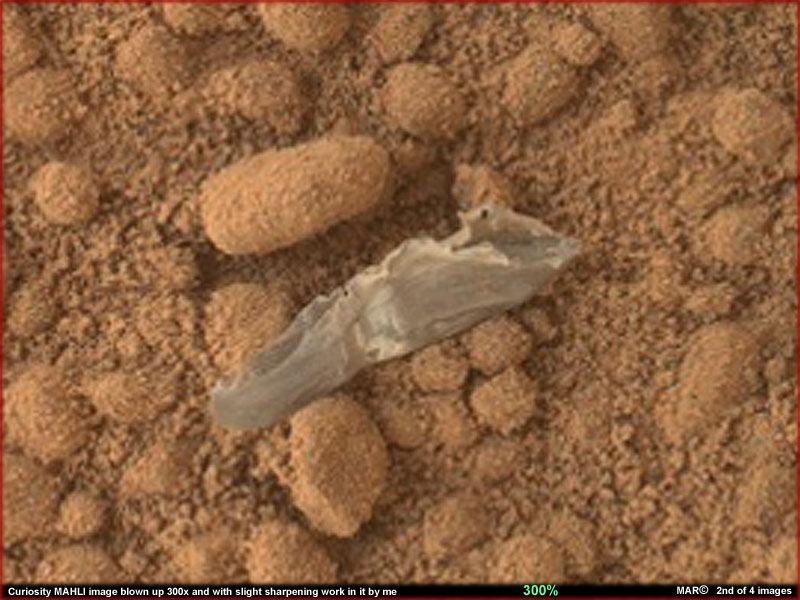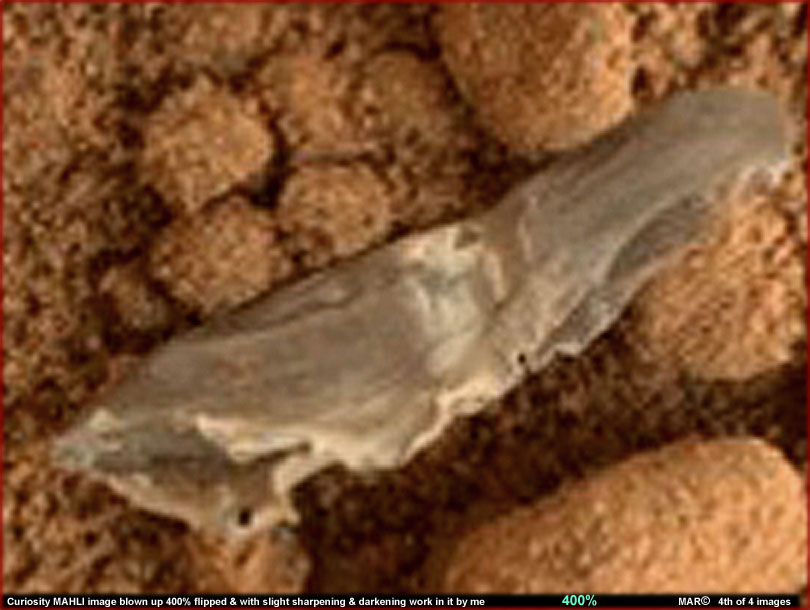
CURIOSITY MAHLI Anomalies-2
Report #236
August 11, 2014
This report zeros in on only a small bit of discarded substance that is out of place in this Mars crater floor environment and as such requires a little elaboration. It is photographed by the MSL Curiosity rover MAHLI (Mars Hand Lens Imager) camera on the Sol 065 page and exists in all but three images on that Sol 065 page. I picked the 2nd horizontal row of images and the 3rd from the left image to work with but any of several other images there would do just as well although I suspect would not be better than the one I've used. Now here's the evidence.

http://mars.jpl.nasa.gov/msl-raw-images/msss/00065/mhli/0065MH0243000005C0_DXXX.jpg



http://mars.jpl.nasa.gov/msl-raw-images/msss/00065/mhli/0065MH0243000005C0_DXXX.jpg
This particular evidence has previously
been discovered by others and I am not the first. My question then of myself
was whether or not I thought I might have anything of importance to add to
their findings as this evidence appears around the Internet. As you can see
by my progressively closer and closer imaging above, I obviously thought I
saw something informative here that might need pointing out. If others have
already done so, I am unaware of it and confess now that I haven't really
researched their work.
According to the official position and what is not suppose to be on Mars,
some small bit of debris like this has no place. After all, rock and soil
geology simply could not produce what has the appearance of a small torn discarded
plastic wrapper. If it is really on Mars as it is reported to be and as officials
would have us believe via the Curiosity imaging, then the most likely scenario
is that it is plastic wrap which denotes civilization of some kind or it might
be a piece of vegetation or an insect sheath or exoskeleton molt, none of
which origins are suppose to exist on Mars.
Yet, although any of this would be especially anomalous on the Mars NASA presents
to us, the amazing thing is that it seems to have generated little interest
within the MSL science team. That might be understandable if the MSL team
has reason to be confident in anticipating bigger more definitive discoveries
from the Curiosity rover efforts further down the line or if they know that
these terrain images being released to the public are really of Earth and
no one wants to waste their time and risk their reputation on stuff suspected
of being false. That caution may be healthy for them but it's not conducive
to truth.
This object also has the look of a whole skinned fish body processed for later
eating with the head, tail, fins, and guts removed but then dropped on the
ground and/or treated rough so that the cut access places have become ragged.
However, since this is the MAHLI camera, this object would logically be much
too small as a meal for that to be likely. Further, the object appears likely
to be thin and semi-transparent looking more like its original purpose was
as a skin or covering of some kind that would be very light and fragile. An
alternative more likely interpretation might be that the object is the husk
of some plant or insect that lost its protective exterior skin through molt.
So it could be organic plant or insect material.
However, the progressively closer views of the object I've provided a view
of here suggest that this object is none of those things but rather a thin
and torn bit of plastic wrapper. Heavy in favor of this reasoning other than
general appearance is what appears to be a white background label visible
within the mid area of the wrapper complete with something just out of focus
printed on it. The only thing missing is a bar code. If this reasoning is
correct, then it is at minimum indicative of something made by civilization
and that of course is also not suppose to exist on Mars.
The question then becomes is it a wrapper native to Mars or Earth? Is it something
lost by someone on Mars or off of the Curiosity rover as it landed or as it
traveled along? Or, could it actually be part of a scene of Earth terrain
used in image tampering but later the evidence overlooked by those indulging
in such activity? The key to these questions lies in the wrapper itself and
the white background label that is part of it. Unfortunately, the label print
information is just too small and fuzzy looking to stand out sharp enough
for interpretation by itself.
If it is discarded plastic wrap, then that label and what is printed on it
is ultra important. It would not be good to spend a lot of speculation on
the wrapper's Mars origin only to learn later that a clearer unreleased camera
shot revealed it to be a Japanese (or the like) label and therefore of Earth
origin. Remember that we are dealing with MSSS, JPL, and NASA here with a
lot riding on the line and I for one would not trust someone in those groups
to not deploy such a counter strategy that would have little or nothing to
do with the truth. Independent researchers like me do not have vast numbers
of "experts" or a media that will give official counter measures
the look of credibility and so we must be wary.
Let's just say that regardless of whether the object is of civilization, vegetation,
or insect origin, it is portrayed as being on Mars and isn't suppose to be
there according to the official position and especially not after 65 days
of traversing the Mars crater floor in its trek. Unless the MSL team can produce
images confirming it is actually of Earth origin, the evidence speaks for
itself and is a liability for those who would try to ignore that it exists.
, Investigator
![]()